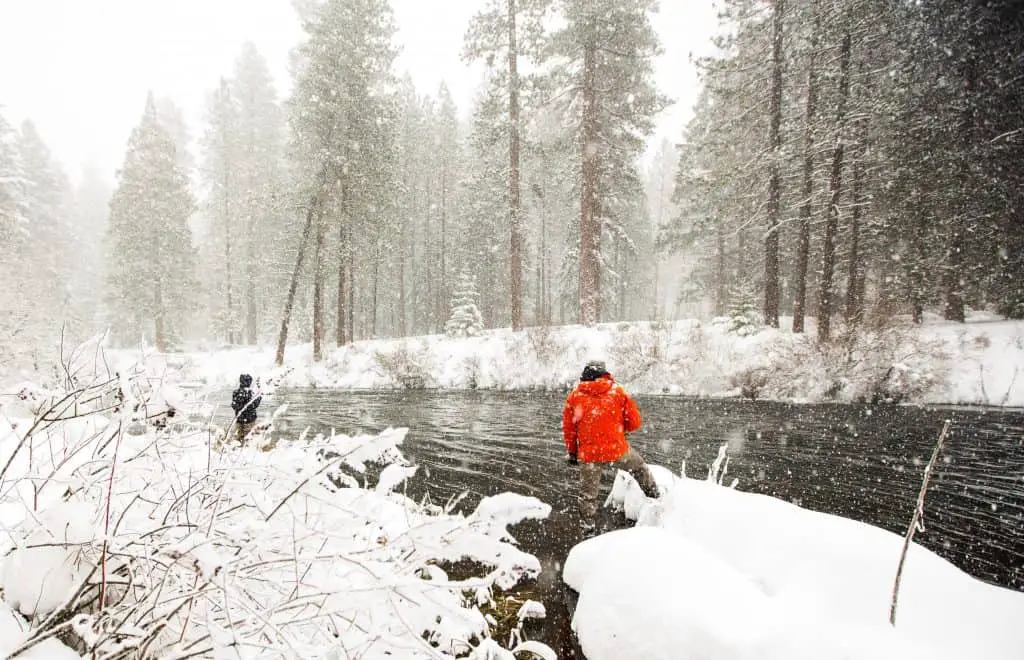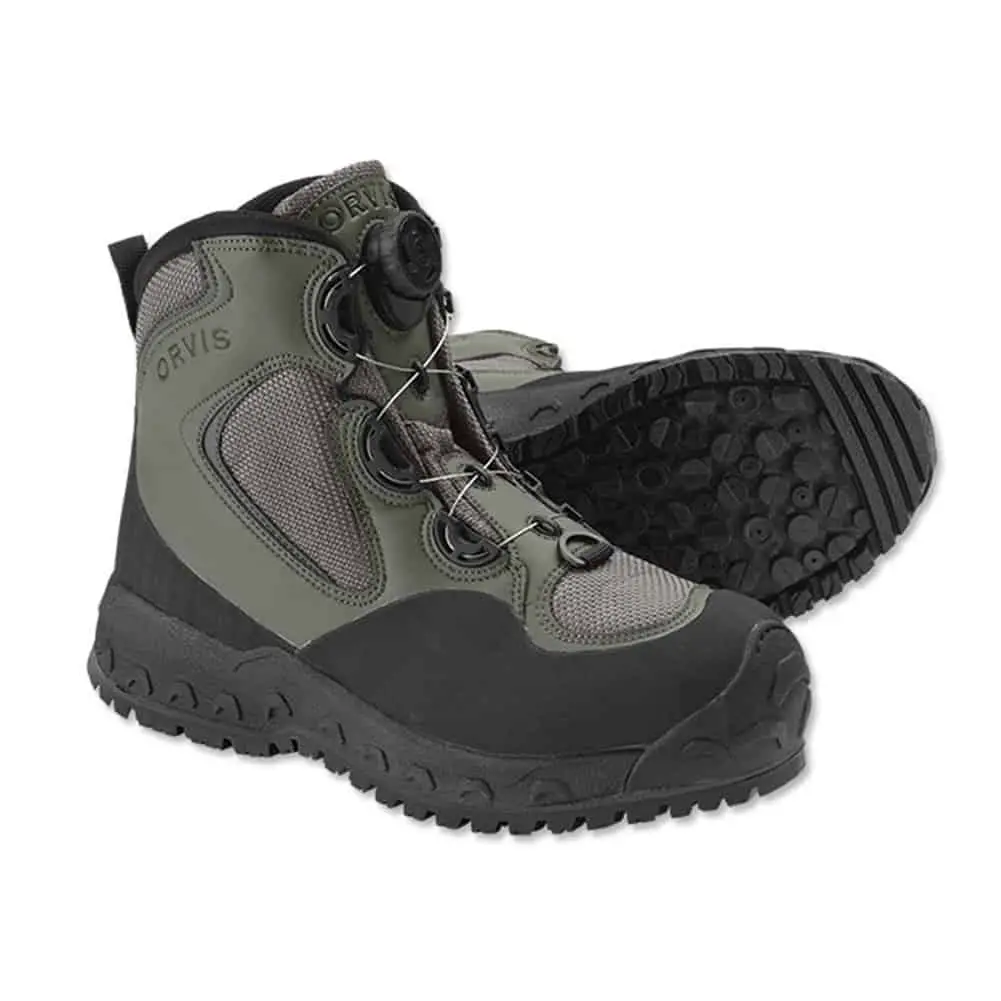As an Amazon Associate we earn from qualifying purchases.
Fly fishermen are always dealing with the cold. Trout, salmon, steelhead, pike, and char are our favorite targets, and all these species live in cold water, usually in cold places. And while we may all prefer a warm spring or fall day, the fish don’t stop biting when winter comes around, so we keep fishing, even when it’s cold.
So naturally, we need our equipment to match the environment we’re so often in; the cold. Arguably the most important piece of equipment that fly fishermen use to keep warm is waders.
I’ll give you the summary, then go into why waders are so important in the first place, and break down some of the major differences.
Table of Contents
Best Waders for Cold Water Summary
Why Do Fly Fishermen Need Waders?
Waders’ most important purpose is that they designate fly fishermen as experts in their craft. They show people that you know what you’re doing, and that you look good while you’re doing it.
You aren’t just some Ricky who grabbed a fishing pole and a can of worms to go catch supper. You’re a fly fisherman with class, skill, and grace. You practice the time-honored tradition of catching fish the hard way, the right way- with a fly rod. That’s why you wear waders. Just kidding.
But seriously, waders are important, and their utility goes beyond that of their initial characteristics. Obviously, their job is to keep you dry, but what does staying dry enable you to do?
Waders give you the ability to get closer to the fish. Standing on the shore and casting into the river is an adequate tactic in small streams, but in larger rivers it’s not an option- you can’t cast 100 feet all day (or probably at all).
But if you’re wearing waders, you can wade out 40 or 50 feet (depending on the depth) and get to a comfortable distance away from the fish that you see feeding. This gives you the opportunity to make a better cast, spot the larger fish, and fish the run more effectively.
Waders also allow you to fish in places where fishing from the shore isn’t an option. These situations occur in small or medium sized rivers where there are bushes, trees, or anything else blocking your back cast. By walking out into the river, you have room to bring your line back. If you’re fishing these places without waders, you better hope it’s warm enough outside for you to get wet.
Wearing waders also allow you to cross the stream to fish from the other side (as long as it’s shallow enough to walk safely). Fishermen who don’t wear waders are committed to fishing on one side of the river, or they have to walk to the nearest bridge.
And finally (and in my mind most importantly) wearing waders allows you to connect with the river. There’s a feeling of unity with the water that I only feel when I’m standing in it that I can’t adequately describe, but it’s one of the many reasons why I love to fly fish.
Obviously, waders are important. So now let’s learn a little bit more about them.
Types of Waders
You can divide fly fishing waders into 3 or 4 broad categories; stockingfoot, bootfoot, chest waders and hip waders. Lastly, waders are either made from heavy neoprene (older or cheaper models), or layered waterproof breathable fabric.
First you have stockingfoot waders. Stockingfoot waders are basically a full body wetsuit. If you’ve ever worn a onesie, imagine that. It’s a waterproof toe to neck body suit.
To fish in stockingfoot waders, you’ll also need a pair of wading boots. Because the boots are a separate item, they’ll cost you more money.
Then you have bootfoot waders. As you can tell by the name, these come with boots attached to the waders, sparing you an additional purpose. These are the old school waders you see fly fishermen wearing and the waders you see duck hunters wearing.
And lastly, you have hip waders. These only go to (you guessed it) your hip. Usually hip waders have built in boots as well, but not always (some are made from breathable materials).
Each of these types of waders has their advantages and disadvantages, but for the purpose of our original question, we can eliminate hip waders. Hip waders don’t provide the insulation or waterproofing that the other types do, so you shouldn’t be wearing them in the cold.
Stockingfoot or Bootfoot Waders for The Cold
When it comes to choosing a pair of waders in the cold, you will have to decide between stockingfoot and bootfoot waders. Each of them have their advantages and disadvantages.
Stockingfoot waders are more maneuverable. Because the boot is not attached to the waders, your ankle has more range of motion. Bootfoot waders are one piece, so the boots don’t have the flexion to allow your ankle to move around. If you’ve ever walked around in tall rubber boots, that’s what it feels like to walk in bootfoot waders.
The boots worn with stockingfoot waders also provide more ankle support than the bootfoot waders. They’re made with leather or stiff nylon and Gore-Tex and other strong materials that prevent your ankle from getting rolled, twisted, and sprained. So, if you’re walking on slippery rocks or around boulders that can trip you up, stockingfoot waders will probably be your best bet. Additionally, there are many choices of wading boots to pair with stocking foot breathable waders. Boots will fit differently by brand, so make sure you try them on with the waders on. A good rule of thumb is to go one size up on your boots, so your feet have plenty of room for circulation.
Bootfoot waders do have some advantages over stockingfoot waders though when it comes to fishing in the cold. The structure of the rubber boot will keep the cold water away from your body thus keeping your body warmer. Also, bootfoot waders will often have built in insulation- on the coldest days this can make all the difference.
Best Waders for Cold Water
With all of that to consider, here are the best waders for cold water.
Orvis Men’s Ultralight Convertible Wader
Orvis is one of the most trusted brands for all fly fishing gear, so it’s no surprise that Orvis makes a great pair of waders. Their Ultralight Convertible Waders are the perfect pair for fishing in warm or cold weather.
They’re light, versatile, and durable. If you buy a pair of these, they’ll last you as long as you take care of them. The fit is modern and comfortable, allowing for you to move around easily and quickly.
These have a magnetic snap on system for converting the waders to hip height. The external storage pocket is completely waterproof and perfect for storing electronics. And the stockings have an integrated gravel guard that prevents drag on the boots.
I wear these waders in all seasons, cold and warm. They’re the perfect pair of all around waders, especially in cold water. Think steelhead fishing, salmon fishing, or cold trout streams. Yeah… you get the picture.
Patagonia Men’s Rio Gallegos Waders

Patagonia’s Rio Gallegos Waders are some of the finest in its class. While less affordable compared to the Orvis Ultralight’s, Patagonia’s product is known for its utmost quality.
This model is the highest performing the company offers. It is durable, completely waterproof, but yet breathable and maneuverable. The trim fit in the upper-body is perfect for layering (which we’ll talk more about later), while still reducing bulk.
The Rio Gallegos have several luxurious features. Its fabric contains Patagonia’s patented H2NO technology which leads its field in water repellency. And the highly puncture resistance means you won’t have pesky holes in your waders.
It’s easy to convert quickly to waist height on hot days, and allows for a quick piss without having shedding layers. There’s a large chest pocket, a reach-through hand warmer pocket, and a handy utility keeper on the suspenders for easy access to nippers and hemostats.
These waders are great for all seasons, but especially for fishing in the winter. I highly recommend them.
Simms G4Z Waders
And lastly, we have the Simms G4Z Waders.

Simms is one of the oldest and most trusted brands in fly fishing. And when it comes to waders, Simms sets the standard. Of all the pros I’ve fished with, they almost always wear Simms waders.
These are the Ferrari of the fly fishing waders world. You simply can’t find anything better. They have all the features, pass all the tests, and tip all the scales. If you’re looking for the absolute best pair of waders for fly fishing in the winter, look no further than the Simms G4Z.
The Gore-Tex Pro Shell fabric is especially crafted for a combination of durability and breathability- two of the most important qualities of a pair of waders. They sport easy high waist conversion, have micro-fleece lined hand warming pockets, 2 zippered chest pockets, and pretty much every other feature you can ask for.
If you have the money for them, the G4Z waders are the best you can buy.
How To Stay Warm Fly Fishing in the Winter
So now you know what kind of waders to buy and you’re well on your way to staying warm while you’re fly fishing in the winter. But, waders alone won’t keep you warm. You have to know how to dress.
First, if you can, consider buying waders and wading boots that give you room to layer. Go a half size up on your boots so you can wear a pair of thick socks (or two). Wear waders that aren’t tight so you can fit a pair of thick long johns on your bottoms, or even a pair of insulated pants.
Make sure your entire outer layer is waterproof, not just your waders. You never know when you may slip, trip, get splashed, or somehow or another end up getting your upper body wet. Being wet and cold is the worst case scenario in winter fly fishing, so be sure you’re wearing a waterproof jacket.
You’ll also want to dress in multiple layers so that you can shed one if you get too warm. The objective is fighting the cold, but if you get too hot you’ll start to sweat, and sweating can get you very cold very fast.
And ensure that your base layer stays dry as well. Though you’ll be cold, fly fishing can require working up a sweat a lot of times, so be sure you’re wearing a moisture wicking base layer to keep dry. Wool and synthetic fabrics work best and avoid cotton at all costs.
Best Waders for Cold Water Conclusion
So, that’s how you stay warm while fly fishing in the winter. Buy the right pair of waders, wear appropriate layers, stay dry, and you’ll be able to catch fish even in the coldest weather.
Use this advice and get out there in the cold. Take advantage of the lonely rivers while you still can.
And if you catch any fish while you’re out there, tell us the story in the comments below!
Amazon and the Amazon logo are trademarks of Amazon.com, Inc, or its affiliates.




I love trout fishing, been doing it since i was 8. I’m 53 now.about 15 years ago i was introduced to steelhead fishing. It,s like fishing for the trout we have here in WV ecept they,re like the hulk of trout fishing so much bigger. so i have some experience with waders but this was very informitive to me thanks MIKE SORCH WV